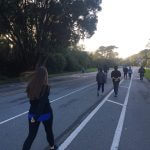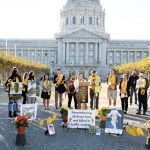We’re *this* close to a major win for safe streets and Vision Zero
2021 presented a crucial opportunity to make our streets safer for you, me, and everyone who walks.
2021 is when the City would create its next ‘Vision Zero Action Strategy’: the blueprint for exactly what the City will do to improve traffic safety over the next three years.
Together with our members, the 30+ groups in the Vision Zero Coalition, and Families for Safe Streets, we wanted this strategy to be as focused, aggressive, and ambitious as possible to finally bring down severe and fatal crashes.
After months of advocacy, with so many of you speaking out at public meetings (and with strong leadership from the SFMTA Board of Directors), a major win is now at hand.
This Tuesday, the SFMTA Board will vote on whether to approve the final Vision Zero Action Strategy. And I’m thrilled to share that this strategy is incredibly promising – and one we can all be proud of. It’s focused on what has proven most effective in reducing crashes, and brings forward these solutions at a meaningful scale.
Walk SF will speak in support of the strategy at Tuesday’s meeting, and invite you to as well.
Now’s the time to show our support and appreciation for the commitments in the Strategy. Here’s why:
- It commits to complete 20 Quick Build projects / year. This means that the 80 miles of designated high-injury streets still awaiting meaningful safety fixes will have them by 2024. Quick Builds have proven to be the fastest, most affordable means for the City to redesign dangerous streets.
- It commits to complete 100% of continental crosswalks, daylighting, and leading pedestrian intervals on the high-injury network by 2024 (with daylighting done by 2023!). It also moves much closer to completing pedestrian countdowns and accessible pedestrian signals within the same timeframe. When layered, these safety improvements bring significantly safer conditions for people crossing the street.
- It commits to plan a citywide active transportation network with car-free and car-lite spaces like Slow Streets. For significantly more people to be able to walk and bike for more trips, they need truly safe and comfortable places to do so – that also connect neighborhoods and key destinations.
- It commits to create a comprehensive speed management plan in 2022. With speed as the #1 cause of severe and fatal crashes, lowering speeds is the most powerful lever in getting to Vision Zero. We’re so glad the City is going to bring new focus and coordinated actions around this.
Let’s show our gratitude and support adoption of the new strategy
The commitments in the final Vision Zero Action Strategy are strong, and the strategy has come a long way from the initial draft. I’m grateful to SFMTA staff for listening and responding to feedback, and for finding ways to expand the Quick Build commitment and hasten crosswalk improvements.
I’m also thrilled that SFMTA is already proposing the first streets to get new, lower 20 MPH speed limits starting in January! This is fresh off the recent passage of Assembly Bill 43, which gives cities more flexibility in setting speed limits.
At Tuesday’s SFMTA Board meeting, staff will discuss the seven commercial corridors to bring reduced speed limits to: Fillmore, Polk, Haight, Valencia, 24th, Ocean and San Bruno. And this is just a start.
The combination of the new strategy and new possibilities with speed-limit setting is big news for making much-needed progress toward Vision Zero. So please join me in thanking the SFMTA and telling them to keep up the good work on Tuesday.
Thank you and what’s next
We are deeply grateful to our partners in the Vision Zero Coalition, Families for Safe Streets, plus the many members and others who pushed so hard this year. This final strategy is the strongest traffic safety plan yet since San Francisco committed to Vision Zero in 2014. Moving forward, it will be all about making sure that the City stays focused in following through on its commitments to make safer streets a reality.




